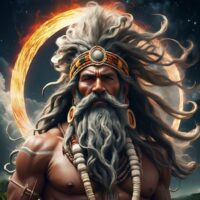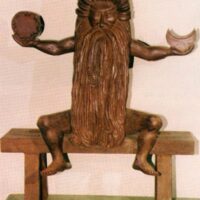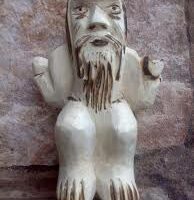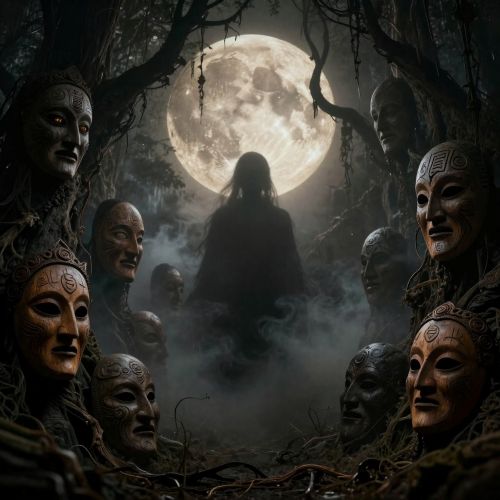Tupa : The Supreme God
Listen
At a glance
| Description | |
|---|---|
| Origin | Guarani Mythology |
| Classification | Gods |
| Family Members | Arasy (Wife) |
| Region | Paraguay, Brazil, and Argentina |
| Associated With | Supreme Powers, Creation |
Tupa
Introduction
Tupa, the supreme deity of the Guarani people, occupies a central place in their mythology and spiritual worldview. Revered as the divine creator, Tupa is credited with shaping not only the earth and sky but also instilling life and order throughout the universe. His presence is deeply felt across the indigenous cultures of Paraguay, Brazil, and Argentina, where he is seen not just as a god but as the source of wisdom and harmony. Tupa’s mythology isn’t isolated in ancient lore—it remains a living narrative that influences contemporary Guarani identity, values, and rituals.
Physical Traits
Unlike anthropomorphic gods in many traditions, Tupa is rarely given a fixed physical form. Instead, his essence is expressed through nature—he manifests in thunderclaps, lightning strikes, and the intensity of storms. These natural elements are not just signs of his power but embodiments of his divine essence. In some local variations, he is imagined as a radiant or luminous presence, representing the sun’s brilliance or celestial energy. In others, he may appear in more symbolic shapes such as a stout, hairy figure, combining earthiness with awe. The lack of a singular depiction speaks to his vastness and transcendence, allowing each community to interpret his presence through its own environmental and spiritual lens.
Family
Tupa is not a solitary figure in Guarani mythology. His divine counterpart is Arasy, the moon goddess, who plays a vital role in the formation of life and the cosmos. Their partnership reflects balance and duality—light and darkness, male and female, sky and earth. According to creation myths, they descended to Earth together and brought humanity into existence, embedding love and purpose into the act of creation.
Their union also resulted in the shaping of moral order. While Arasy nurtures and protects, Tupa brings law and wisdom. Other spiritual beings—like Angatupyry, the spirit of good, and Tau, the spirit of evil—were created to represent the ongoing internal struggle between virtue and temptation. Tupa’s influence extends to a broader divine family including deities like Karai, the god of fire, and Jakaira, the spirit of fog and fertility. These figures function within a divine ecosystem shaped and sustained by Tupa’s original creative act.
Other names
Tupa is known by a variety of names across different regions and Guarani-speaking groups, reflecting the richness and diversity of his worship. Variants such as Tupâ, Tupan Tupa, Tenondete, Nanderuvucu, and Monan emphasize different attributes of the deity—some highlight his thunderous power, while others focus on his role as the original or “first father.”
Over time, colonial influences attempted to assimilate Tupa into Christian frameworks. Missionaries often equated him with the Christian God, using his name in their translations of religious texts. This led to syncretic practices where Tupa was seen through both indigenous and Christian lenses. However, in traditional belief systems, he remains a distinct figure within a pantheon—not a solitary, omnipotent god but the central force in a complex spiritual world.
Powers and Abilities
Tupa’s powers extend well beyond basic creation. As the divine force behind all existence, he controls elemental forces—thunder, lightning, wind, and fire are his tools of communication and transformation. His dominion over the sky allows him to bring storms or sunshine, influencing not just the weather but the fate of crops, rivers, and people.
More importantly, Tupa is a giver of knowledge. After creating the world, he didn’t abandon it—he taught humanity how to live. These teachings included moral guidelines, skills for survival such as hunting and farming, and the understanding of right and wrong. Through his wisdom, early Guarani societies built systems of community, law, and spiritual practice.
Tupa also governs time and cosmic cycles. By creating the sun and moon, he gave rhythm to life—defining days, nights, seasons, and ceremonies. His presence is felt in the balance of the universe, and his power continues to guide spiritual leaders, known as pajés, in their rituals and visions.
Modern Day Influence
Despite centuries of colonization and cultural disruption, the figure of Tupa remains deeply respected and relevant. In remote Guarani communities, his name is still spoken in prayers, sung in songs, and honored in seasonal rituals. These ceremonies are not merely nostalgic—they affirm an ongoing relationship with the natural world, one where Tupa’s legacy lives in every tree, storm, and stream.
Beyond religious observance, Tupa has also found a place in contemporary cultural expressions. Writers, artists, and scholars exploring indigenous identity frequently invoke Tupa as a symbol of resistance, creation, and continuity. His story is taught in classrooms that center indigenous perspectives, and his teachings are used to bridge discussions between environmental sustainability and spiritual balance.
Tupa’s mythology also resonates with ecological movements. His role as a protector of the land makes him an icon for conservation and indigenous land rights. In activist circles, references to Tupa often highlight the wisdom embedded in Guarani traditions—particularly the idea that humanity must live in harmony with the Earth, not apart from it.
Related Images
Source
Ancient Origins. (2015, April 22). The gods of creation and legendary beasts of the Guarani. Retrieved June 5, 2025, from https://www.ancient-origins.net/myths-legends-americas/gods-creation-and-legendary-beasts-guarani-005373
Gallois, D. T., & Macedo, V. (2018). Nas redes Guarani: Saberes, traduções e transformações. Ed. Hedra. Retrieved June 5, 2025, from https://hedra.com.br/livro/nas-redes-guarani/
Native Languages. (n.d.). Guarani legends (folklore, myths, and traditional Indian stories). Retrieved June 5, 2025, from https://www.native-languages.org/guarani-legends.htm
Sacred Blend. (n.d.). Brazilian Indigenous Mythology. Retrieved June 5, 2025, from https://sacredblend.com/brazilian-indigenous-mythology/
Shapiro, J. (2018). From Tupã to the land without evil: The christianization of Tupi-Guarani cosmology. In Across the boundaries of belief. Taylor & Francis. https://doi.org/10.4324/9781315275306
Simons Paraguay. (2024, September 5). The Guarani Creation Myth. Retrieved June 5, 2025, from https://simonsparaguay.com/guarani-creation-myth/
TV Tropes. (n.d.). Myth / Tupi-Guarani Mythology. Retrieved June 5, 2025, from https://tvtropes.org/pmwiki/pmwiki.php/Myth/TupiGuaraniMythology
Wikipedia. (n.d.). Tupã (mythology). Retrieved June 5, 2025, from https://en.wikipedia.org/wiki/Tup%C3%A3_(mythology)
Frequently Asked Questions
What is lorem Ipsum?
I am text block. Click edit button to change this text. Lorem ipsum dolor sit amet, consectetur adipiscing elit. Ut elit tellus, luctus nec ullamcorper mattis, pulvinar dapibus leo.
What is lorem Ipsum?
I am text block. Click edit button to change this text. Lorem ipsum dolor sit amet, consectetur adipiscing elit. Ut elit tellus, luctus nec ullamcorper mattis, pulvinar dapibus leo.
What is lorem Ipsum?
I am text block. Click edit button to change this text. Lorem ipsum dolor sit amet, consectetur adipiscing elit. Ut elit tellus, luctus nec ullamcorper mattis, pulvinar dapibus leo.
What is lorem Ipsum?
I am text block. Click edit button to change this text. Lorem ipsum dolor sit amet, consectetur adipiscing elit. Ut elit tellus, luctus nec ullamcorper mattis, pulvinar dapibus leo.
What is lorem Ipsum?
I am text block. Click edit button to change this text. Lorem ipsum dolor sit amet, consectetur adipiscing elit. Ut elit tellus, luctus nec ullamcorper mattis, pulvinar dapibus leo.









